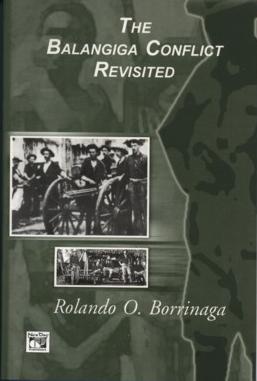
premiered in The CORRESPONDENTS Program on August 15, 2006, after 11:00 p.m.

The English translation of all talking parts in the ABS-CBN documentary, “Mga Kampana ng Balangiga (The Bells of Balangiga),” by Abner P. Mercado, reporter of The CORRESPONDENTS Program. It was premiered on August 15, 2006, after 11:00 p.m. The translation was done by Prof. Rolando O. Borrinaga of the Balangiga Research Group (BRG).

|
The webmaster's book, The Balangiga Conflict Revisited, is now off the press. It is published by New Day Publishers in Quezon City. Should you wish to get a copy, please call up the office of New Day Publishers at (632)928-8046, (632) 927-5982, or e-mail them at newdayorders@edsamail.com.ph. Copies are also now available at National Book Store outlets all over the country. In the U.S., copies may be ordered from Philippine Expressions Bookshop, 2114 Trudie Drive, Rancho Palos Verdes, Ca 90275-2006, Tel. (310)514-9139, Fax (310)514-3485, email: lindanietes@earthlink.net. The linked article above is the webmaster's column item about his book, published in the INQUIRER Visayas section of the Philippine Daily Inquirer on March 15, 2003. |
In the morning of Saturday, September 28, 1901, hundreds of native fighters mostly armed with bolos staged a successful surprise attack on soldiers of Company C, 9th US Infantry Regiment, who were mostly eating breakfast in the garrisoned town of Balangiga, at the southern coast of Samar Island in the Philippines.
The natives plotted to resist forced starvation on a famine season due to the destruction or confiscation of their food stocks, to free about 80 male residents who had been rounded up for forced labor and detained for days in crowded conditions with little food and water, and to fight for honor after having been publicly shamed and provoked by these two military impositions.
The event, known in history as the Balangiga Massacre, was described by the US military as its "worst single defeat" in the Philippines and among the worst defeats in its entire history.
The Filipino victory in Balangiga was followed by a shameful episode that the US government has not yet regretted nor apologized for. American military authorities retaliated with a "kill and burn" policy to take back Samar, deliberately equating a victorious small town with an entire island, from October 1901 to January 1902.
The Balangiga Massacre is popularly associated with three church bells of varying sizes, all taken as "war trophies" and brought to the US. The smallest bell is on permanent display at the traveling museum of the 9th US Infantry, now stationed in Korea. The two bigger bells are displayed at the Trophy Park at the F.E. Warren Air Force Base in Cheyenne, Wyoming.
The return of these bells to the Philippines remains the last issue of contention between the US and Philippine governments related to the Philippine-American War.
The Year 2000 was a turning point in the webmaster's
Balangiga advocacy both in terms of
language and content.
The webmaster's Balangiga advocacy started in 1994,
with a strong pitch for
the return of the Bells of Balangiga
in Wyoming. It had a language and style of its own
until 1999.
Includes a poster art and concept for the 1998 UP Balangiga Historical Tour,
updated brochure material with thematic photographs, a symposium paper,
introduction of an
American descendant and a Filipino descendant as
symposium keynote speakers, and
landmarks.